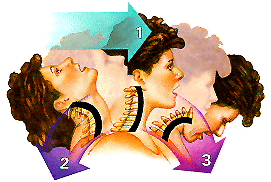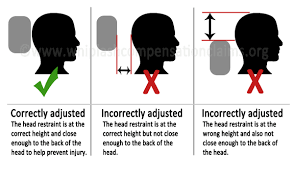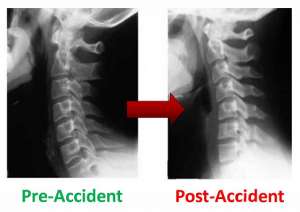You’ve been in an auto accident. What now?
 These days, now more than ever, cars are crashing into each other at an alarming rate. Why? It’s the drivers, stupid. Distractions like texting, dialing, and even talking on a cell phone are the big issues. Many of us live in states where there are limited restrictions on this activity. As a doctor of chiropractic, I am an advocate for maximum penalties regarding cell phone use and driving.There has been way too much human damage as a result of this carelessness. Be that as it may, if you are the victim of a car crash there is a lot to think about and sometimes little time for appropriate action. The best way to deal with this unfortunate possibility is to think ahead and have a plan. The best plan is, “Quick, get me to my chiropractor.”
These days, now more than ever, cars are crashing into each other at an alarming rate. Why? It’s the drivers, stupid. Distractions like texting, dialing, and even talking on a cell phone are the big issues. Many of us live in states where there are limited restrictions on this activity. As a doctor of chiropractic, I am an advocate for maximum penalties regarding cell phone use and driving.There has been way too much human damage as a result of this carelessness. Be that as it may, if you are the victim of a car crash there is a lot to think about and sometimes little time for appropriate action. The best way to deal with this unfortunate possibility is to think ahead and have a plan. The best plan is, “Quick, get me to my chiropractor.”
Front end collisions usually involve air bag deployment. Pow! In your face comes the bag, faster than you can frame in your brain what just happened. You may have been the careless driver that allowed yourself to be distracted or another driver may have pulled in front of you by surprise and left you no choice but to hit them. Either way, there you are. The airbag is designed to save you from getting mashed into the steering wheel, which can really hurt at 50 – 60 mph. The airbag can also cause severe injuries to the cervical spine and face, particularly if your hand happens to get between the bag and the face. Injuries to the wrist and forearm fractures, facial lacerations, eye injuries and jaw dislocations can result due to airbag deployment. The air bag may save your life but the more subtle injuries from airbag deployment should not be discounted. Cervical spine whiplash and subluxation are the main concerns of doctors of chiropractic and there is no more effective and efficient treatment method to help you recover to your maximum potential.
Rear end collisions require another kind of special insight so that the injured are effectively diagnosed and treated. When your car is struck from behind you are usually unaware of what is happening except for the sound of screeching tires. There are many factors that determine the outcome and potential for serious injuries. The simple act of adjusting your headrest before you drive is huge. With the headrest elevated to just above the middle of the back of your head you avoid the ramping whiplash injury. When your car is suddenly thrust forward from a rear end impact you simultaneously are thrust backward and upward into your seat and your head will ramp up and over the headrest if it is improperly adjusted and too low on your head. This can result in a serious cervical spine sprain strain extension injury. Extension injuries cause serious compressive forces of the tiny cervical spine joints known as facets.
The injury mainly sets off a flurry of inflammation reactions in the neck which results in pain and stiffness. When spine joints swell the potential to interfere with normal nervous system transmission through the spinal cord and related nerve roots is very real. Many auto crash victims begin to have radiant pains and numbness and tingling sensations into their arms and hands. The nerve may not be physically pinched by the bone but it is certainly being physically pinched by the injured soft tissue swelling. This is where the chiropractic approach is truly amazing. With the use of therapeutic modalities for pain management and home care ice and heat routines, the road to recovery is faster and more immediate. The longer you wait to be seen in this scenario, the worse your pain and the longer your healing process.
The second aspect of injury from the rear end impact involves the whiplash injury. After your head is forced back into the headrest, the car usually lurches forward and suddenly stops. This usually happens because your foot is forced down upon the brake pedal. If this doesn’t happen, then your car is forced into the car ahead of you and once again a forced stop occurs that may trigger airbag deployment. This is a lot of trouble for your neck. Even with the headrest properly positioned, recent slow motion analysis shows the neck bowing backward into the headrest and being forced into conformity with the space that exists between the forward headrest contact point and the recessed support bars.

This is another sprain strain assault on the joint structure soft tissues of the neck. After that, the head is forcibly lurched forward due to the sudden stop of the car. This again, overstretches the joint capsular tissue and potentially ruptures the disc, which is exposed to tremendous axial loading pressure. Even if no bones are fractured, the softer tissue damage is substantial and the potential for subluxation and severe misalignment is probable. This all causes a substantial impediment to normal nervous system function.
Proper care requires fast action. Proper assessment for potential concussion and head and neck fractures is the first order of business, because those conditions are life threatening. Once they have been ruled out, the overall condition of the cervical spine is assessed for sprain, strain and nerve pinch syndromes, such as brachial plexus injuries, nerve root compression and radiculitis. These are a bunch of big words that are mainly related to pain, numbness, tingling, muscle weakness and other issues. Many times injuries to the neck involve headache as a result of vascular related migraine activity. Whatever has happened as a result of the collision, a proper history and examination must be undertaken.
This examination may result in the need for X-ray, CT scan or even MRI.  The next step is controlling swelling and inflammation of the joint and tendinous tissues. The use of ice and heat applications and some bracing may be necessary. Keep the anti-inflammatory medications to a minimum and instead use herbal preparations of turmeric, Boswellia, celery seed, arnica and ginger.A good assessment of the nutritional system is important as many people suffer from deficiencies of such important trace minerals and vitamins such as manganese, zinc and Vitamin C to name a few, that are important to tissue healing processes. Once the pain and swelling are properly addressed, we then look at alignment and set about to gently and painlessly correct any subluxations and malalignments. With proper time, attention and adjustments it is amazing how the spinal tissue can heal. Healing is sometimes complete but unfortunately, many times the tissues can never fully recover and the patient is left with a residual permanent injury. Fortunately, even a permanent injuries can be managed with continued supportive chiropractic care, which is a far cry better than managing pain with a never ending intake of medicines with their often dangerous side effects.
The next step is controlling swelling and inflammation of the joint and tendinous tissues. The use of ice and heat applications and some bracing may be necessary. Keep the anti-inflammatory medications to a minimum and instead use herbal preparations of turmeric, Boswellia, celery seed, arnica and ginger.A good assessment of the nutritional system is important as many people suffer from deficiencies of such important trace minerals and vitamins such as manganese, zinc and Vitamin C to name a few, that are important to tissue healing processes. Once the pain and swelling are properly addressed, we then look at alignment and set about to gently and painlessly correct any subluxations and malalignments. With proper time, attention and adjustments it is amazing how the spinal tissue can heal. Healing is sometimes complete but unfortunately, many times the tissues can never fully recover and the patient is left with a residual permanent injury. Fortunately, even a permanent injuries can be managed with continued supportive chiropractic care, which is a far cry better than managing pain with a never ending intake of medicines with their often dangerous side effects.
Chiropractic care is a very good thing for auto crash injuries. The faster you get to your chiropractor the better. You’ve been injured in a crash! What now? “Get me to my chiropractor.”
